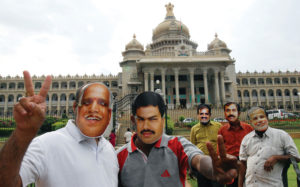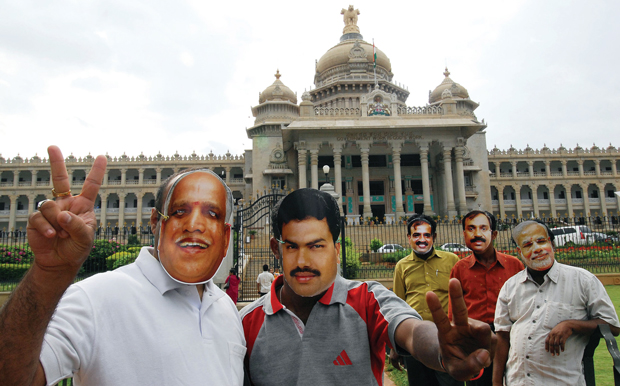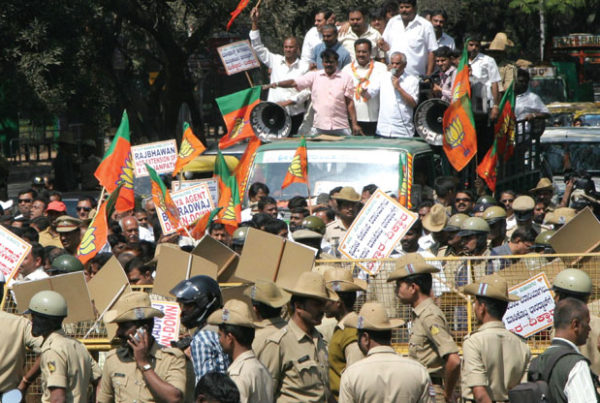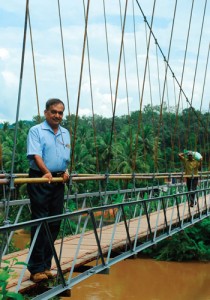The BJP’s victory in Karnataka clearly reflects the dominance of the Sangh Parivar and caste politics, reports Sanjana Chappalli
 Fervour unmasked: BJP supporters in Bengaluru wear masks of Yeddyurappa, By Raghavendra and Modi. Photo: S Radhakrishna
Fervour unmasked: BJP supporters in Bengaluru wear masks of Yeddyurappa, By Raghavendra and Modi. Photo: S RadhakrishnaIN MAY 2008, two days after he was elected chief minister of Karnataka, BS Yeddyurappa attributed all his political experience to his Hindu right-wing background with the Sangh Parivar. “I will follow their decisions. It is their guidance that will help me make the correct decisions,” he had said back then. A year later, with his declaration still holding true, Yeddyurappa has been instrumental in ensuring that 19 of Karnataka’s 28 Lok Sabha seats went to the Bharatiya Janata Party (BJP) — the political unit of the Sangh Parivar.
In his journey, Yeddyurappa has been known to bulldoze all attempts to question his leadership within the party. Prior to elections, protests erupted within the state BJP unit against Yeddyurappa’s negotiation of a party ticket for his son BY Raghavendra from the Shimoga constituency. One senior party leader, and then sitting MP, Basanagouda Patil Yatnal, resigned over what he termed “dilution of party ideology through Yeddyurappa’s dynastic politics.” BJP insiders say that he was allowed his way and a ticket was granted to his son since Yeddyurappa had been delivering the goods on every other front.
His almost dictatorial grip within the BJP sharply contrasts with his subservience to the Sangh leaders. In fact, it is only the Sangh leaders who are known to wield any influence on him. In the run-up to the elections, Yeddyurappa was summoned twice by the RSS state leaders to contain differences between him and senior BJP leader HN Ananthkumar. That the two leaders have been at loggerheads since Yeddyurappa’s nomination as the BJP’s chief ministerial candidate prior to the 2008 assembly elections is no hidden matter. Despite Ananthkumar’s proximity to BJP’s national leaders, Yeddyurappa, given his own Lingayat background, was handed the chief ministerial mantle. (In Karnataka, the Lingayats are more important as a vote bank compared to Ananthkumar’s Brahmin community.)
YEDDYURAPPA’S GRIP WITHIN THE BJP CONTRASTS WITH HIS SUBSERVIENCE TO THE SANGH LEADERS
The processes that successfully worked to ensure the BJP’s victory in the Karnataka assembly elections a year ago were replayed to maximize the party’s gains in the Lok Sabha elections. One of the fundamental, and perhaps expected, reasons for the BJP’s stellar performance in these elections (winning 19 seats has been their best-ever performance in the state) has been the close relationship that it has maintained with the Rashtriya Swayamsevak Sangh (RSS), and it’s affiliates, such as the Bajrang Dal and the Vishwa Hindu Parishad (VHP). Party sources openly admit that the BJP candidates in several instances were nominated by the RSS. Political greenhorns like Ananthkumar Hegde and Nalin Kumar Kateel, who had spent a few years in the BJP, were nominated as candidates on the basis of their sustained participation (and hence influence) within the Sangh. They were placed in areas where the Sangh enjoyed considerable sway — coastal Karnataka and parts of central Karnataka. Support on the ground was mobilised by the Sangh cadres and the candidates won, even if by slim victory margins. Kateel trounced Congress veteran B Janardhan Poojary in Dakshina Kannada while Anantkumar Hegde defeated another Congress heavyweight, Margaret Alva, on her home turf in Uttara Kannada district. Wielding his influence as the chief minister of the state, Yeddyurappa has also openly endorsed the Sangh organisations — and the support that they extend to the BJP — on several occasions. A clear case in point was his decision to sanction the withdrawal of several pending cases against Bajrang Dal activists in the state. In the eyes of the Sangh activists, Yeddyurappa’s stature as a leader only grew. “We know that he will come forward to defend us — if there is a need. He understands that we are all working for the same cause,” says Vinay Shetty, convener of the Dakshina Kannada Bajrang Dal unit.
YEDDYURAPPA’S RISE to power, both within the BJP and outside, was largely possible through the consolidation of the 1.5 crore Lingayat population into the Sangh fold. In February 2009, with elections imminent, 19 sub-sects of the Lingayat community were added to the list of Backward Castes in Karnataka. The move, widely known to be engineered by Yeddyurappa, ensured that the community was eligible for a much sought over 5 percent reservation in education and employment sectors. Even as the BJP and the Sangh maintained its hold on the Lingayat community in the Lok Sabha elections, Other Backward Caste communities like the Idigas and the Billavas too voted en masse for the BJP. In Shimoga, Yeddyurappa’s home district and now MP BY Raghavendra’s home turf, the Idiga association leaders were very clear about their decision to vote for the BJP. “We were told that supporting the BJP would bring us long-term gains. We have seen what they have done for the Lingayats, maybe the same benefits will reach our community too?” explains Chandrappa Naik. Following the delimitation process, there was a concentration of the Idiga community in the Shimoga constituency. Naik, who runs a series of educational institutions in the district, also alleges that the BJP was handing out cash in excess of the amount allowed by the Election Commission rules. According to the Chief Electoral Officer in Karnataka, MN Vidyashankar, 142 cases of violations were reported from Shimoga — the third highest in the state. Raghavendra finally trounced former Chief Minister and Idiga community leader, S Bangarappa by over 52,000 votes. A similar tale unfolded in Dakshina Kannada district, where the combined strength of the Idiga and Billava community moved closer to the Sangh and voted for the BJP candidate, Kateel. Congress old hand B Janardhan Poojary lost there by over 40,000 votes.
THE CONSOLIDATION OF THE LINGAYATS INTO THE SANGH FOLD LED TO YEDDYURAPPA’S RISE
The Hindu vote bank consolidation across castes and communities has largely been possible through Yeddyurappa’s pandering to the communities’ interests. The benefits Naik hopes that the Idiga community too will gain include the generous grants made by the chief minister to the Lingayat mutts and seers. Already, the influence of such seats, including the Sri Siddaganga Mutt in Tumkur, Sri Pejavara Adhokshaja Mutt in Udupi, and the JSS mutt in Suttur, has grown considerably under Yeddyurappa’s patronage. In return for financial allocations, the mutts and their devotees have thrown their full weight behind the chief minister.
The BJP’s losses at the national level notwithstanding, what could possibly be the consequences of its win in Karnataka?
Hours after the BJP candidate from Dakshina Kannada constituency in coastal Karnataka was declared victorious, violence erupted in the Bantwal region of the constituency, 10 km from Mangalore. Supporters of Nalin Kumar Kateel, first-time BJP MP, barged into the homes of several Muslims and assaulted them with cricket bats, cycle chains, lathis and bottles. Police arrested four people, even as Kateel himself dismissed the violence as “celebrations gone astray.”
For BS Yeddyurappa, however, these were irrelevant deatils. “We have to see the BJP win in Karnataka only as a pro-development verdict — nothing else,” he said. “People are happy with our government.”
—
This article was originally published in Tehelka, a leading independent news magazine in India, known for its investigative journalism.



